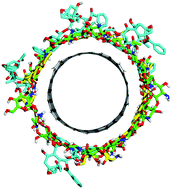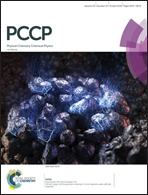Understanding the co-loading and releasing of doxorubicin and paclitaxel using chitosan functionalized single-walled carbon nanotubes by molecular dynamics simulations†
Abstract
Two widely used anticancer drugs, doxorubicin (DOX) and paclitaxel (PTX), possess distinct physical properties and chemotherapy specificity. In order to investigate their interaction mechanism with single-walled carbon nanotubes (SWCNTs), co-loading and releasing from the SWCNTs, all-atom molecular dynamics (MD) simulations were firstly carried out for different SWCNT systems, followed by binding free energy calculation with MM-PBSA. The results indicate that the co-loading of DOX and PTX onto the pristine SWCNT is exothermic and spontaneous. The DOX molecules predominantly interact with the SWCNT via π–π stacking through the conjugated aromatic rings, while the separated aromatic rings of PTX also primarily interact with the SWCNT through π–π stacking yet supplemented by an X–π (X = C–H, N–H and C![[double bond, length as m-dash]](https://www.rsc.org/images/entities/char_e001.gif) O) interaction. Moreover, the strongest binding of DOX and PTX with the pristine SWCNT shows similar strength (ΔG: −32.0 vs. −33.8 kcal mol−1). For the chitosan functionalized SWCNT (f-SWCNT), the DOX and PTX molecules still prefer binding to the sidewall of the CNT rather than binding with the polymer, and the non-covalent functionalization of the SWCNT with chitosan decreases the binding of DOX and PTX with the sidewall of the f-SWCNT as compared with the DOX/PTX–SWCNT system (ΔG: −24.0 and −21.9 kcal mol−1). The protonation of chitosan and drug molecules further weakens the interaction between DOX/PTX and the f-SWCNT, and shows a consequent displacement of the drug molecules, triggering the release of the drugs. The variation of binding strength of the three systems (DOX/PTX–SWCNT, DOX/PTX–f-SWCNT, and DOXH+/PTXH+–f-SWCNT) was also discussed in terms of the histogram or frequency of the distance from the drugs to the SWCNT. In addition, the encapsulation of two DOX molecules by the f-SWCNT is considerably stronger than the binding of the other six drug molecules to the sidewall, indicating that the encapsulation of anticancer drugs may also play a very important role and should be considered in the drug delivery.
O) interaction. Moreover, the strongest binding of DOX and PTX with the pristine SWCNT shows similar strength (ΔG: −32.0 vs. −33.8 kcal mol−1). For the chitosan functionalized SWCNT (f-SWCNT), the DOX and PTX molecules still prefer binding to the sidewall of the CNT rather than binding with the polymer, and the non-covalent functionalization of the SWCNT with chitosan decreases the binding of DOX and PTX with the sidewall of the f-SWCNT as compared with the DOX/PTX–SWCNT system (ΔG: −24.0 and −21.9 kcal mol−1). The protonation of chitosan and drug molecules further weakens the interaction between DOX/PTX and the f-SWCNT, and shows a consequent displacement of the drug molecules, triggering the release of the drugs. The variation of binding strength of the three systems (DOX/PTX–SWCNT, DOX/PTX–f-SWCNT, and DOXH+/PTXH+–f-SWCNT) was also discussed in terms of the histogram or frequency of the distance from the drugs to the SWCNT. In addition, the encapsulation of two DOX molecules by the f-SWCNT is considerably stronger than the binding of the other six drug molecules to the sidewall, indicating that the encapsulation of anticancer drugs may also play a very important role and should be considered in the drug delivery.



 Please wait while we load your content...
Please wait while we load your content...